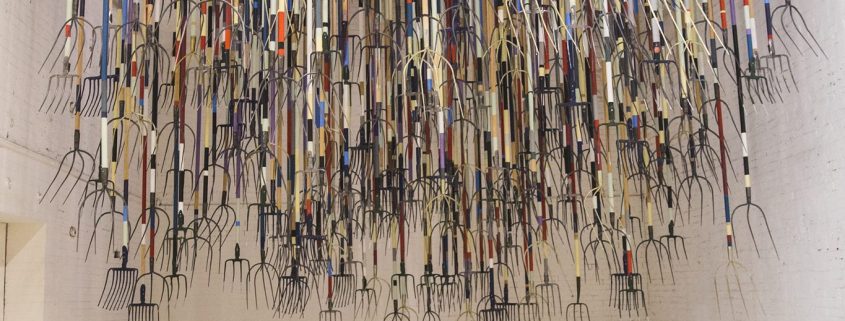The 14th Factory turns barren land into a diverse and interactive visual masterpiece
Located in an abandoned 150,000-square-foot warehouse in Lincoln Heights, one wouldn’t think much of The 14th Factory museum’s unassuming, all-black exterior. However, inside holds an immersive and mesmerizing universe like no other.
The museum features 14 interlinked art installations that showcase video, sculpture, paintings and live dance. Founded by British and Hong Kong-based artist Simon Birch, the museum was created with the intention of making the space not an ordinary experience, but a journey of discovery.
Birch and his diverse team of 16 artists from China, Hong Kong, the United States, United Kingdom. and Canada took this everyday space and transformed it into a haven of interdisciplinary and socially engaged art that draws from American and Asian cultures. Around every corner, the museum offers diverse, socially conscious and interactive works of art.
According to the museum’s website, Birch was inspired by the 18th-century history of the Canton region called Thirteen Factories when developing the project. Birch even invested $1 million of his own funds toward the project, which originally had a $3 million budget.
Birch stated in the 14th Factory website that he wanted to create a space where people could open “a new alternative space of collaboration, production and transformation,” combining the old and new.
The 14th Factory creates global community and unity through existential messages and social justice through the representation of minority artists and subjects and original, dramatic pieces of art. In between the dramatic installations, visitors move through tunnels in complete darkness, adding to the mystique.
While all the individual exhibits have the ability to leave guests constantly amazed, a crowd favorite is The Barmecide Feast, designed by lead architect Paul Kember and his team. Introduced as an interstellar meteor that breaks open in the middle into a room inspired by the film 2001: A Space Odyssey, guests can experience an exact replica of the bedroom from director Stanley Kubrick’s set. Kembers’ uncle and great-uncle were both designers who worked on the original sets in Kubrick’s film
Visitors are allowed a timed visit of two minutes, similar to the restrictions at the Museum of Ice Cream for the sprinkles pool and The Broad for Yayoi Kusama’s Infinity Mirrored Room.
The final exhibit, The Inevitable (The Final Challenge: Death and Rebirth) by Birch and Eric Hu, is as shocking as it is fascinating. The film installation features Birch’s beloved red Ferrari being destroyed on screen in slow-motion from various angles. In the next room, the physical pieces of the destroyed Ferrari are on the table for view.
Birch created The Inevitable after his diagnosis diagnosis with non-Hodgkins lymphoma and was told that he only had six months left to live. After the life-changing incident, Birch realized that material wealth can be absolutely insignificant, according to Forbes magazine
Other iconic exhibits include The Crusher, a room with 300 pitchforks suspended from the ceiling that look as if they could fall down at any minute, representing revolution.
The various film installations showcase a wide range of subjects, including one with 300 Chinese fighters in slow motion and Tannhauser by videographer Scott Sporleder, based on a concept by Birch that features vacated apartment buildings in Hong Kong.
While Los Angeles is a cultural hub for art, few are as enlightening as The 14th Factory. With its collaborative and innovative approach, The 14th Factory weaves the past, the present and the future together by uniquely displaying art inspired by Chinese history, all while giving a voice to artists of color.
Admission is $18 at the door and $15 online. As the museum is also a documentary project, visitors must sign a waiver agreeing to be filmed upon entering. The pop-up museum was originally scheduled to run until April 30, but recently extended visits into May.

